Child Development: Physical, Social, Emotional Development Assignment
VerifiedAdded on 2022/11/24
|13
|3394
|2
Homework Assignment
AI Summary
This assignment delves into the multifaceted realm of child development, encompassing three key areas: physical/motor, social/emotional, and cognitive development. It begins by outlining the fundamental aspects of physical development, including fine and gross motor skills, and then examines factors influencing this development, such as maturation, heredity, and health. The assignment provides practical scenarios to analyze developmental challenges and offers examples of motor skills observed in preschool children. It also outlines daily physical activity recommendations for children and explores how educators can contribute to a child's physical health, providing examples of activities and resources. The assignment further explores the social and emotional development of children, including the impact of factors like gender and family crisis, and examines the stages of psychosocial development according to Erik Erikson. It provides strategies for educators to support children's social and emotional growth, fostering skills like cooperation, communication, and social interaction. Furthermore, it addresses the creation of supportive environments, the promotion of community belonging, and the support of children's creativity through physical environments and educator-led activities. The assignment also covers self-image and identity exploration and concludes with the importance of the physical environment in promoting creativity and learning, referencing the National Quality Standard.
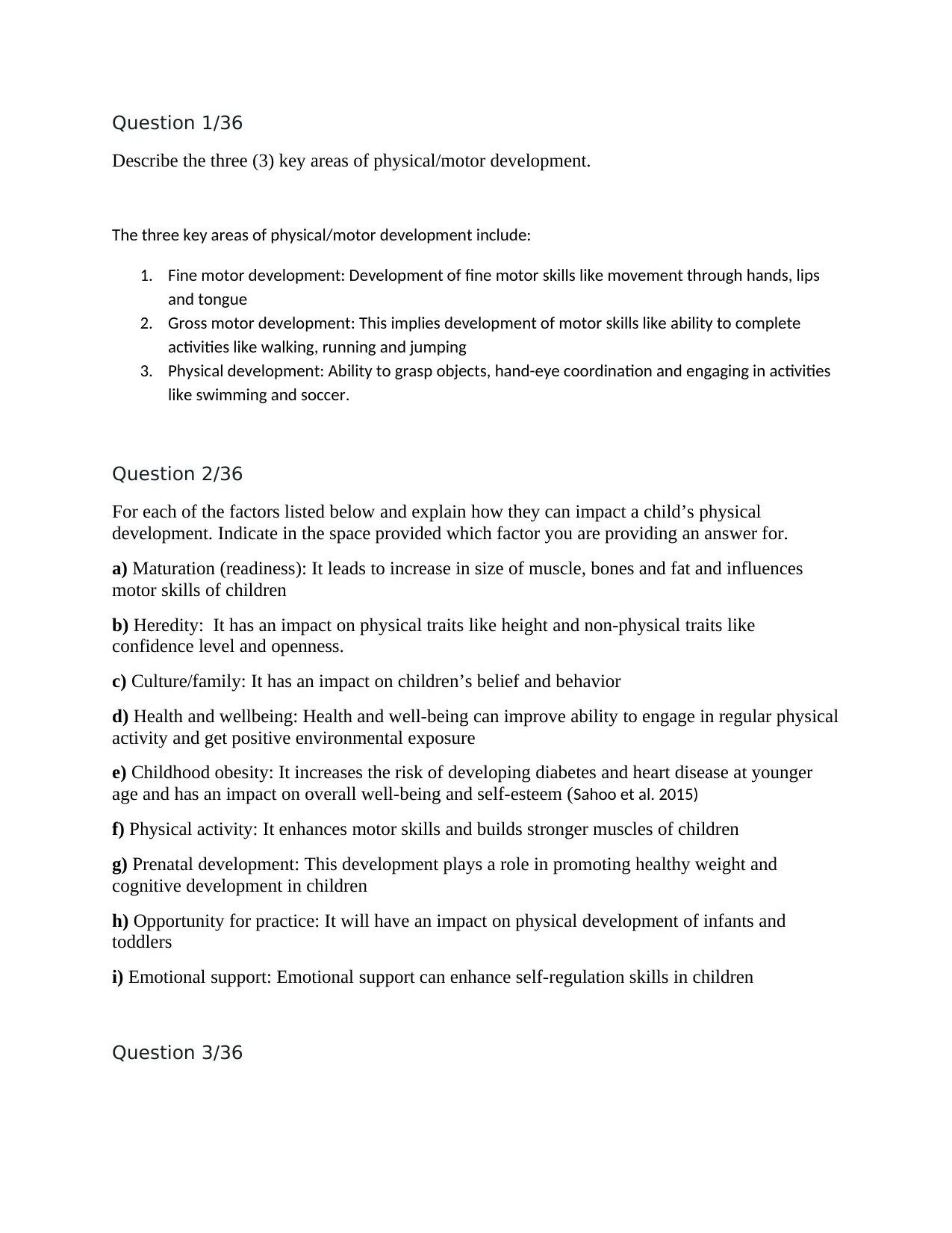
Question 1/36
Describe the three (3) key areas of physical/motor development.
The three key areas of physical/motor development include:
1. Fine motor development: Development of fine motor skills like movement through hands, lips
and tongue
2. Gross motor development: This implies development of motor skills like ability to complete
activities like walking, running and jumping
3. Physical development: Ability to grasp objects, hand-eye coordination and engaging in activities
like swimming and soccer.
Question 2/36
For each of the factors listed below and explain how they can impact a child’s physical
development. Indicate in the space provided which factor you are providing an answer for.
a) Maturation (readiness): It leads to increase in size of muscle, bones and fat and influences
motor skills of children
b) Heredity: It has an impact on physical traits like height and non-physical traits like
confidence level and openness.
c) Culture/family: It has an impact on children’s belief and behavior
d) Health and wellbeing: Health and well-being can improve ability to engage in regular physical
activity and get positive environmental exposure
e) Childhood obesity: It increases the risk of developing diabetes and heart disease at younger
age and has an impact on overall well-being and self-esteem (Sahoo et al. 2015)
f) Physical activity: It enhances motor skills and builds stronger muscles of children
g) Prenatal development: This development plays a role in promoting healthy weight and
cognitive development in children
h) Opportunity for practice: It will have an impact on physical development of infants and
toddlers
i) Emotional support: Emotional support can enhance self-regulation skills in children
Question 3/36
Describe the three (3) key areas of physical/motor development.
The three key areas of physical/motor development include:
1. Fine motor development: Development of fine motor skills like movement through hands, lips
and tongue
2. Gross motor development: This implies development of motor skills like ability to complete
activities like walking, running and jumping
3. Physical development: Ability to grasp objects, hand-eye coordination and engaging in activities
like swimming and soccer.
Question 2/36
For each of the factors listed below and explain how they can impact a child’s physical
development. Indicate in the space provided which factor you are providing an answer for.
a) Maturation (readiness): It leads to increase in size of muscle, bones and fat and influences
motor skills of children
b) Heredity: It has an impact on physical traits like height and non-physical traits like
confidence level and openness.
c) Culture/family: It has an impact on children’s belief and behavior
d) Health and wellbeing: Health and well-being can improve ability to engage in regular physical
activity and get positive environmental exposure
e) Childhood obesity: It increases the risk of developing diabetes and heart disease at younger
age and has an impact on overall well-being and self-esteem (Sahoo et al. 2015)
f) Physical activity: It enhances motor skills and builds stronger muscles of children
g) Prenatal development: This development plays a role in promoting healthy weight and
cognitive development in children
h) Opportunity for practice: It will have an impact on physical development of infants and
toddlers
i) Emotional support: Emotional support can enhance self-regulation skills in children
Question 3/36
Paraphrase This Document
Need a fresh take? Get an instant paraphrase of this document with our AI Paraphraser

Read the scenarios below and answer the questions that follow. Indicate in the space provided
which question you are answering.
Scenario 1:
An educator, Mary, is trying to teach Rosie (2 years old) how to cut paper with some scissors.
Mary starts to get frustrated with Rosie as she is not able to ‘hold’ the scissors properly between
her fingers. Rosie cannot make the blades of the scissors open and close, so she can’t cut the
paper.
Scenario 2:
Indie (6 months old) is very small for her age, weighing less than a 3 month old. Her mother was
a heavy drug user throughout her pregnancy and gave birth to Indie prematurely.
a) Identify one (1) factor that may be impacting Rosie's physical ability to hold and cut with the
scissors.
b) Identify one (1) factor that may be impacting Indie’s physical development.
1a. Lack of fine motor skills might be affecting Rosie’s ability to hold the
scissors
1b. Maternal alcohol use is associated with poor physical development and birth weight issues
in Indie (Chen 2012).
Question 4/36
For each of the activities below, list two (2) motor skills you might observe in pre-school
children. Indicate in the space provided which skill you are providing an answer for.
a) Meals: Motor skills related to moving the mouth and moving the mouth while eating
b) Puzzles: Fine motor skills related to specialized movements while solving the puzzle
Question 5/36
In the space below, summaries the daily physical activity recommendations according to the
Department of Health for children aged from birth to five-years-old. You may like to refer to the
reading ‘Department of Health – Physical Activities Guidelines’ to assist you with this task.
The recommended physical activity for children between birth to five years are as follows:
1. Infants till the age of 1 year should be encouraged to take part in supervised floor based play
which question you are answering.
Scenario 1:
An educator, Mary, is trying to teach Rosie (2 years old) how to cut paper with some scissors.
Mary starts to get frustrated with Rosie as she is not able to ‘hold’ the scissors properly between
her fingers. Rosie cannot make the blades of the scissors open and close, so she can’t cut the
paper.
Scenario 2:
Indie (6 months old) is very small for her age, weighing less than a 3 month old. Her mother was
a heavy drug user throughout her pregnancy and gave birth to Indie prematurely.
a) Identify one (1) factor that may be impacting Rosie's physical ability to hold and cut with the
scissors.
b) Identify one (1) factor that may be impacting Indie’s physical development.
1a. Lack of fine motor skills might be affecting Rosie’s ability to hold the
scissors
1b. Maternal alcohol use is associated with poor physical development and birth weight issues
in Indie (Chen 2012).
Question 4/36
For each of the activities below, list two (2) motor skills you might observe in pre-school
children. Indicate in the space provided which skill you are providing an answer for.
a) Meals: Motor skills related to moving the mouth and moving the mouth while eating
b) Puzzles: Fine motor skills related to specialized movements while solving the puzzle
Question 5/36
In the space below, summaries the daily physical activity recommendations according to the
Department of Health for children aged from birth to five-years-old. You may like to refer to the
reading ‘Department of Health – Physical Activities Guidelines’ to assist you with this task.
The recommended physical activity for children between birth to five years are as follows:
1. Infants till the age of 1 year should be encouraged to take part in supervised floor based play

2. Toddlers and pre-schoolers should by physically active everyday for at least three hours
(Department of Health, 2018)
Question 6/36
Refer to National Quality Standard 2.1 ‘Each child’s health and physical activity is supported
and promoted’. List three (3) examples of how an educator can contribute to a child’s physical
health.
To support physical health, an educator can take the following steps:
1. Encourage children to punch and play with balloons
2. Arrange outdoor activities like walking and playing with balls in park
3. Promote active play such as running, kicking and throwing
Question 7/36
List five (5) experiences educators can plan and implement to support babies aged 0 - 12 months
with movement and play. You may like to refer to the reading ‘Raising children – Movement and
play for babies’ to assist you with this task.
Five movement and play experiences for babies aged 0-12 years include:
1. Encourage hand and body movement to music and sound
2. Move toys out of reach so that the baby tries to reach it
3. Provide spoons or other objects for babies to bang on pots
4. Encourage baby to move up to stand
5. Make tunnel chairs to help babies crawl
Question 8/36
List five (5) intentional teaching experiences educators can implement to support the physical
development of toddlers.
Five intentional teaching includes:
1. Provide different objects and material during play
2. Allow children to explore materials using sensory properties
(Department of Health, 2018)
Question 6/36
Refer to National Quality Standard 2.1 ‘Each child’s health and physical activity is supported
and promoted’. List three (3) examples of how an educator can contribute to a child’s physical
health.
To support physical health, an educator can take the following steps:
1. Encourage children to punch and play with balloons
2. Arrange outdoor activities like walking and playing with balls in park
3. Promote active play such as running, kicking and throwing
Question 7/36
List five (5) experiences educators can plan and implement to support babies aged 0 - 12 months
with movement and play. You may like to refer to the reading ‘Raising children – Movement and
play for babies’ to assist you with this task.
Five movement and play experiences for babies aged 0-12 years include:
1. Encourage hand and body movement to music and sound
2. Move toys out of reach so that the baby tries to reach it
3. Provide spoons or other objects for babies to bang on pots
4. Encourage baby to move up to stand
5. Make tunnel chairs to help babies crawl
Question 8/36
List five (5) intentional teaching experiences educators can implement to support the physical
development of toddlers.
Five intentional teaching includes:
1. Provide different objects and material during play
2. Allow children to explore materials using sensory properties
⊘ This is a preview!⊘
Do you want full access?
Subscribe today to unlock all pages.

Trusted by 1+ million students worldwide

3. Teach children perception of colors through different colour blocks
4. Support children to play with dough
5. Develop gross motor skills by filling and emptying buckets
Question 9/36
List three (3) examples of outdoor experiences or resources an education and care service could
provide to allow children to explore and experience the natural environment.
Three outdoor resources includes:
1. Balls
2. Jumping rope
3. Sand
Question 10/36
Refer to National Quality Standard 5.1 ‘Respectful and equitable relationships are maintained
with each child’. List three (3) examples of how this standard aims supports a child’s emotional
and social development.
The NQS 5.1 standards support emotional and social development as:
1. It helps to provide adequate space to children
2. Implement flexible routine for children based on their needs
3. Offer culturally appropriate experiences and materials
Question 11/36
Describe how each of the following factors can impact a child’s social and emotional
development. Indicate in the space provided which question you are answering.
a) Gender: Gender plays a role in developing diverse emotional expression in children
b) Social morals: Social morals influence response to adverse situations and promote positive
social outcomes in children
c) Illness or disability: Illness results in emotional distress and poor social contact
d) Family crisis: Family crisis leads to emotional problems and behavioral problems in children
4. Support children to play with dough
5. Develop gross motor skills by filling and emptying buckets
Question 9/36
List three (3) examples of outdoor experiences or resources an education and care service could
provide to allow children to explore and experience the natural environment.
Three outdoor resources includes:
1. Balls
2. Jumping rope
3. Sand
Question 10/36
Refer to National Quality Standard 5.1 ‘Respectful and equitable relationships are maintained
with each child’. List three (3) examples of how this standard aims supports a child’s emotional
and social development.
The NQS 5.1 standards support emotional and social development as:
1. It helps to provide adequate space to children
2. Implement flexible routine for children based on their needs
3. Offer culturally appropriate experiences and materials
Question 11/36
Describe how each of the following factors can impact a child’s social and emotional
development. Indicate in the space provided which question you are answering.
a) Gender: Gender plays a role in developing diverse emotional expression in children
b) Social morals: Social morals influence response to adverse situations and promote positive
social outcomes in children
c) Illness or disability: Illness results in emotional distress and poor social contact
d) Family crisis: Family crisis leads to emotional problems and behavioral problems in children
Paraphrase This Document
Need a fresh take? Get an instant paraphrase of this document with our AI Paraphraser
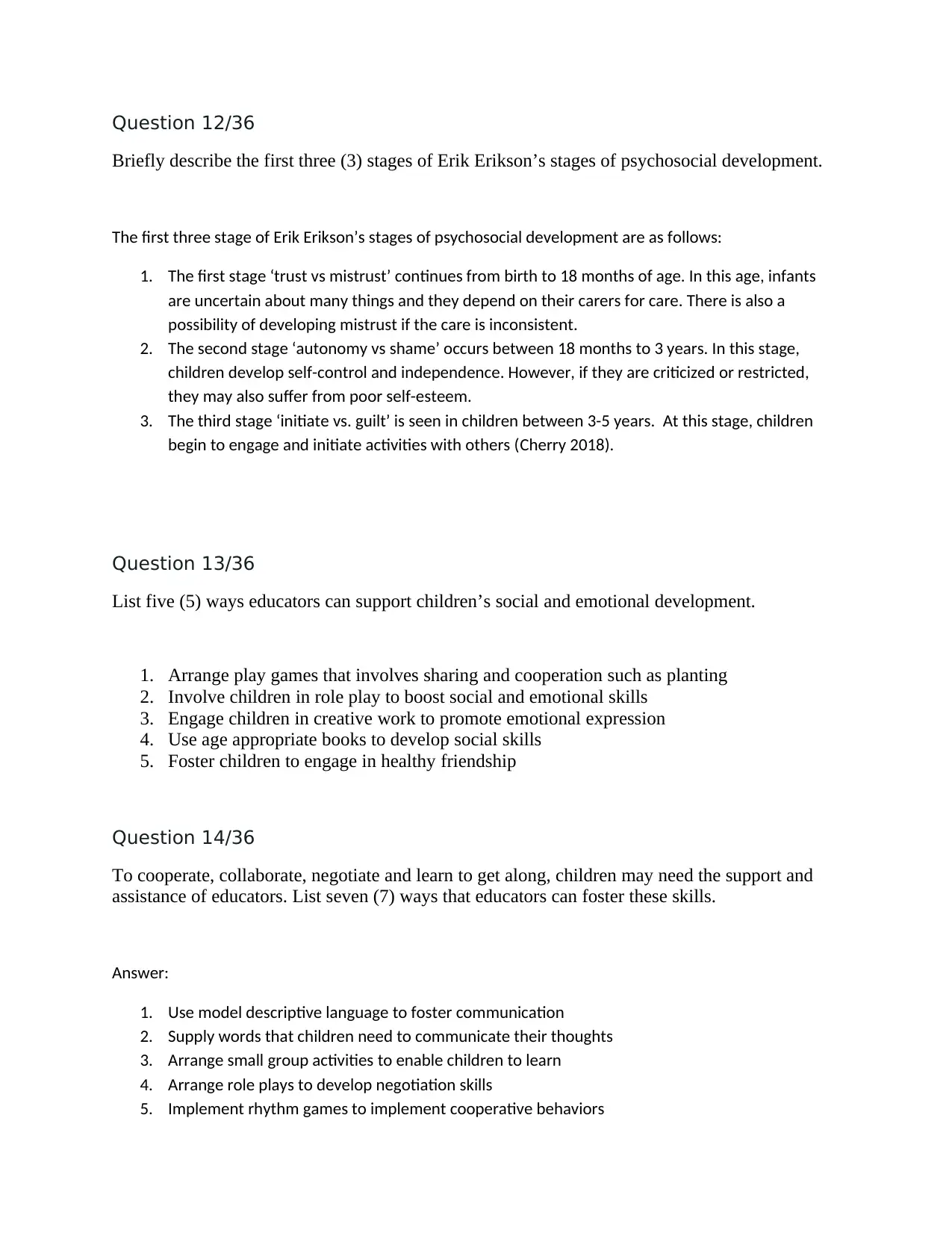
Question 12/36
Briefly describe the first three (3) stages of Erik Erikson’s stages of psychosocial development.
The first three stage of Erik Erikson’s stages of psychosocial development are as follows:
1. The first stage ‘trust vs mistrust’ continues from birth to 18 months of age. In this age, infants
are uncertain about many things and they depend on their carers for care. There is also a
possibility of developing mistrust if the care is inconsistent.
2. The second stage ‘autonomy vs shame’ occurs between 18 months to 3 years. In this stage,
children develop self-control and independence. However, if they are criticized or restricted,
they may also suffer from poor self-esteem.
3. The third stage ‘initiate vs. guilt’ is seen in children between 3-5 years. At this stage, children
begin to engage and initiate activities with others (Cherry 2018).
Question 13/36
List five (5) ways educators can support children’s social and emotional development.
1. Arrange play games that involves sharing and cooperation such as planting
2. Involve children in role play to boost social and emotional skills
3. Engage children in creative work to promote emotional expression
4. Use age appropriate books to develop social skills
5. Foster children to engage in healthy friendship
Question 14/36
To cooperate, collaborate, negotiate and learn to get along, children may need the support and
assistance of educators. List seven (7) ways that educators can foster these skills.
Answer:
1. Use model descriptive language to foster communication
2. Supply words that children need to communicate their thoughts
3. Arrange small group activities to enable children to learn
4. Arrange role plays to develop negotiation skills
5. Implement rhythm games to implement cooperative behaviors
Briefly describe the first three (3) stages of Erik Erikson’s stages of psychosocial development.
The first three stage of Erik Erikson’s stages of psychosocial development are as follows:
1. The first stage ‘trust vs mistrust’ continues from birth to 18 months of age. In this age, infants
are uncertain about many things and they depend on their carers for care. There is also a
possibility of developing mistrust if the care is inconsistent.
2. The second stage ‘autonomy vs shame’ occurs between 18 months to 3 years. In this stage,
children develop self-control and independence. However, if they are criticized or restricted,
they may also suffer from poor self-esteem.
3. The third stage ‘initiate vs. guilt’ is seen in children between 3-5 years. At this stage, children
begin to engage and initiate activities with others (Cherry 2018).
Question 13/36
List five (5) ways educators can support children’s social and emotional development.
1. Arrange play games that involves sharing and cooperation such as planting
2. Involve children in role play to boost social and emotional skills
3. Engage children in creative work to promote emotional expression
4. Use age appropriate books to develop social skills
5. Foster children to engage in healthy friendship
Question 14/36
To cooperate, collaborate, negotiate and learn to get along, children may need the support and
assistance of educators. List seven (7) ways that educators can foster these skills.
Answer:
1. Use model descriptive language to foster communication
2. Supply words that children need to communicate their thoughts
3. Arrange small group activities to enable children to learn
4. Arrange role plays to develop negotiation skills
5. Implement rhythm games to implement cooperative behaviors
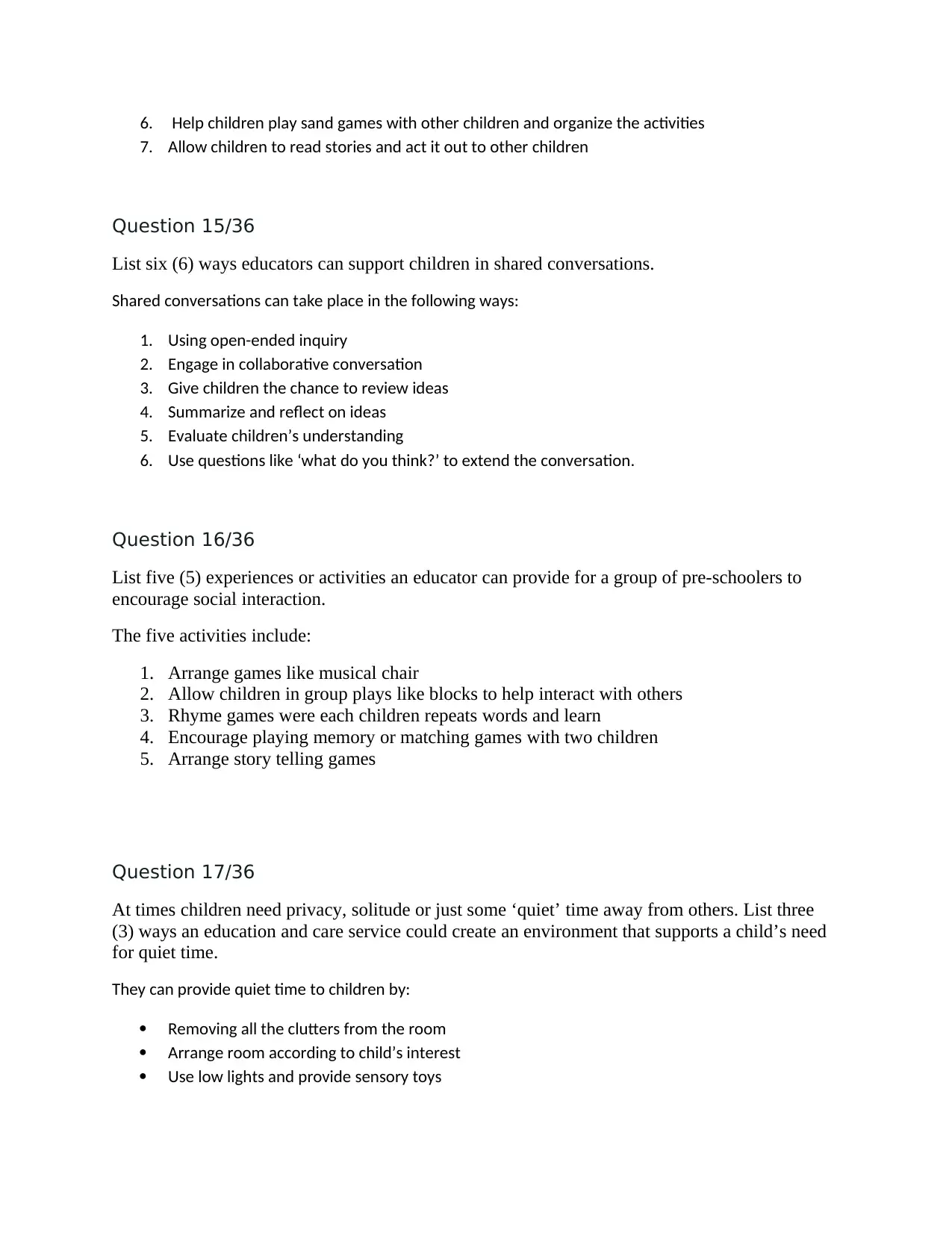
6. Help children play sand games with other children and organize the activities
7. Allow children to read stories and act it out to other children
Question 15/36
List six (6) ways educators can support children in shared conversations.
Shared conversations can take place in the following ways:
1. Using open-ended inquiry
2. Engage in collaborative conversation
3. Give children the chance to review ideas
4. Summarize and reflect on ideas
5. Evaluate children’s understanding
6. Use questions like ‘what do you think?’ to extend the conversation.
Question 16/36
List five (5) experiences or activities an educator can provide for a group of pre-schoolers to
encourage social interaction.
The five activities include:
1. Arrange games like musical chair
2. Allow children in group plays like blocks to help interact with others
3. Rhyme games were each children repeats words and learn
4. Encourage playing memory or matching games with two children
5. Arrange story telling games
Question 17/36
At times children need privacy, solitude or just some ‘quiet’ time away from others. List three
(3) ways an education and care service could create an environment that supports a child’s need
for quiet time.
They can provide quiet time to children by:
Removing all the clutters from the room
Arrange room according to child’s interest
Use low lights and provide sensory toys
7. Allow children to read stories and act it out to other children
Question 15/36
List six (6) ways educators can support children in shared conversations.
Shared conversations can take place in the following ways:
1. Using open-ended inquiry
2. Engage in collaborative conversation
3. Give children the chance to review ideas
4. Summarize and reflect on ideas
5. Evaluate children’s understanding
6. Use questions like ‘what do you think?’ to extend the conversation.
Question 16/36
List five (5) experiences or activities an educator can provide for a group of pre-schoolers to
encourage social interaction.
The five activities include:
1. Arrange games like musical chair
2. Allow children in group plays like blocks to help interact with others
3. Rhyme games were each children repeats words and learn
4. Encourage playing memory or matching games with two children
5. Arrange story telling games
Question 17/36
At times children need privacy, solitude or just some ‘quiet’ time away from others. List three
(3) ways an education and care service could create an environment that supports a child’s need
for quiet time.
They can provide quiet time to children by:
Removing all the clutters from the room
Arrange room according to child’s interest
Use low lights and provide sensory toys
⊘ This is a preview!⊘
Do you want full access?
Subscribe today to unlock all pages.

Trusted by 1+ million students worldwide

Question 18/36
Access the Early Years Learning Framework and refer to ‘Outcome 2 – Children are connected
with and contribute to their world: Children develop a sense of belonging to groups and
communities and an understanding of the reciprocal rights and responsibilities necessary for
active community participation’.
List five (5) examples of how educators can promote this outcome.
Community participation in children can be arranged in the following ways:
Develop child’s interest in cleaning the environment
Advise them to put plastics and other wastes in dust bins
Arrange simple gardening activities
Teach them ways to measure things
Teach caring for elders like parents and grandparents
Question 19/36
List two (2) ways an education and care service can support toddlers and pre-school children to
develop a sense of community, belonging and contribution.
1. Praise children for keeping the classes clean and focusing on clean environment
2. Engage children in interactive and respectful relation with other children
Question 20/36
List five (5) examples of how children’s creativity can be actively supported by educators.
Children’s creativity can be supported in the following ways:
1. Identify child’s interest and encourage them to actively pursue it
2. Supply all resource to help children to develop their creativity
3. Encourage children do things they have never done before
4. Give children autonomy
5. Arrange creative activities like drawing and rehearsing a play
Question 21/36
Describe three (3) ways the physical environment can be used in an education and care service to
support children’s creativity.
Access the Early Years Learning Framework and refer to ‘Outcome 2 – Children are connected
with and contribute to their world: Children develop a sense of belonging to groups and
communities and an understanding of the reciprocal rights and responsibilities necessary for
active community participation’.
List five (5) examples of how educators can promote this outcome.
Community participation in children can be arranged in the following ways:
Develop child’s interest in cleaning the environment
Advise them to put plastics and other wastes in dust bins
Arrange simple gardening activities
Teach them ways to measure things
Teach caring for elders like parents and grandparents
Question 19/36
List two (2) ways an education and care service can support toddlers and pre-school children to
develop a sense of community, belonging and contribution.
1. Praise children for keeping the classes clean and focusing on clean environment
2. Engage children in interactive and respectful relation with other children
Question 20/36
List five (5) examples of how children’s creativity can be actively supported by educators.
Children’s creativity can be supported in the following ways:
1. Identify child’s interest and encourage them to actively pursue it
2. Supply all resource to help children to develop their creativity
3. Encourage children do things they have never done before
4. Give children autonomy
5. Arrange creative activities like drawing and rehearsing a play
Question 21/36
Describe three (3) ways the physical environment can be used in an education and care service to
support children’s creativity.
Paraphrase This Document
Need a fresh take? Get an instant paraphrase of this document with our AI Paraphraser
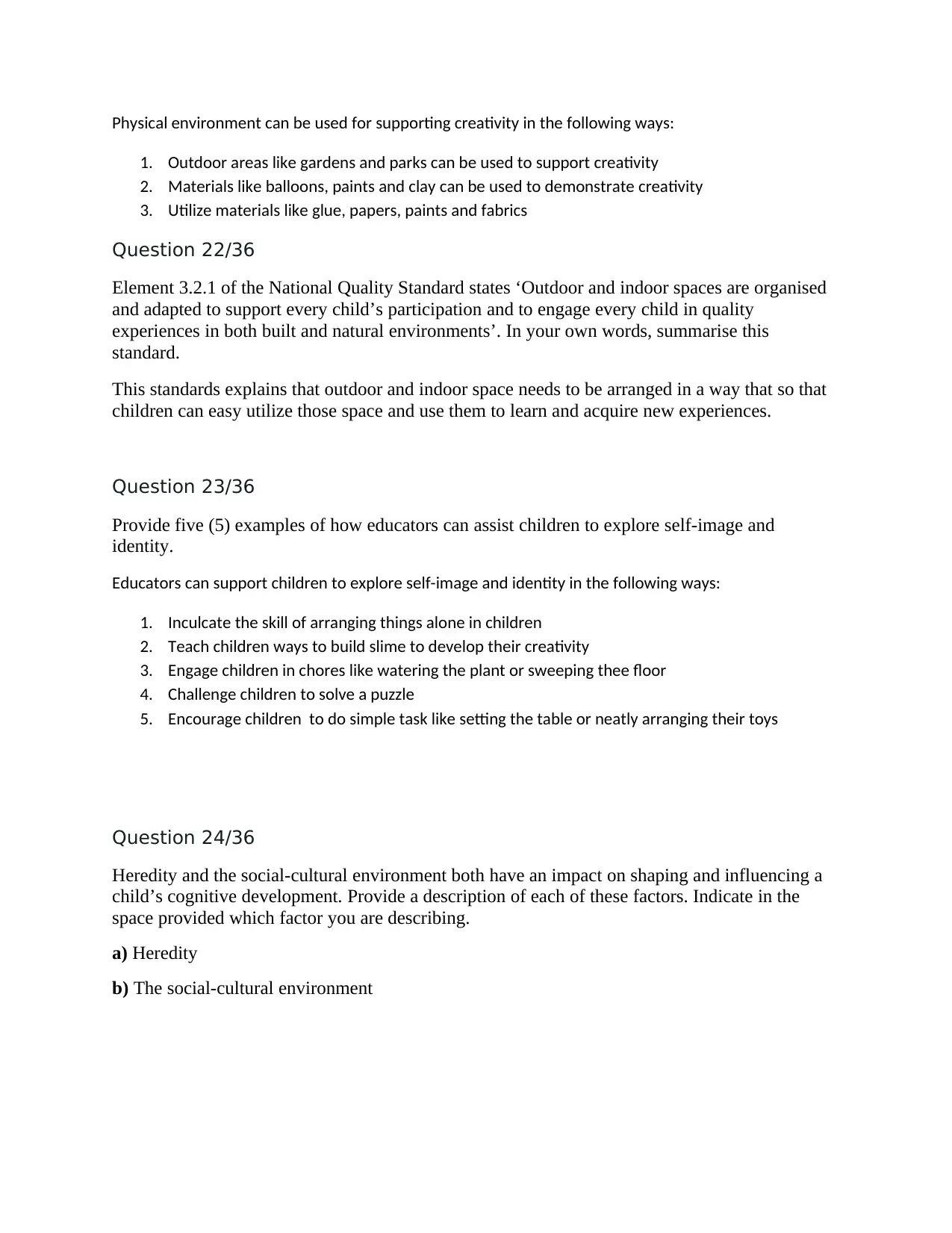
Physical environment can be used for supporting creativity in the following ways:
1. Outdoor areas like gardens and parks can be used to support creativity
2. Materials like balloons, paints and clay can be used to demonstrate creativity
3. Utilize materials like glue, papers, paints and fabrics
Question 22/36
Element 3.2.1 of the National Quality Standard states ‘Outdoor and indoor spaces are organised
and adapted to support every child’s participation and to engage every child in quality
experiences in both built and natural environments’. In your own words, summarise this
standard.
This standards explains that outdoor and indoor space needs to be arranged in a way that so that
children can easy utilize those space and use them to learn and acquire new experiences.
Question 23/36
Provide five (5) examples of how educators can assist children to explore self-image and
identity.
Educators can support children to explore self-image and identity in the following ways:
1. Inculcate the skill of arranging things alone in children
2. Teach children ways to build slime to develop their creativity
3. Engage children in chores like watering the plant or sweeping thee floor
4. Challenge children to solve a puzzle
5. Encourage children to do simple task like setting the table or neatly arranging their toys
Question 24/36
Heredity and the social-cultural environment both have an impact on shaping and influencing a
child’s cognitive development. Provide a description of each of these factors. Indicate in the
space provided which factor you are describing.
a) Heredity
b) The social-cultural environment
1. Outdoor areas like gardens and parks can be used to support creativity
2. Materials like balloons, paints and clay can be used to demonstrate creativity
3. Utilize materials like glue, papers, paints and fabrics
Question 22/36
Element 3.2.1 of the National Quality Standard states ‘Outdoor and indoor spaces are organised
and adapted to support every child’s participation and to engage every child in quality
experiences in both built and natural environments’. In your own words, summarise this
standard.
This standards explains that outdoor and indoor space needs to be arranged in a way that so that
children can easy utilize those space and use them to learn and acquire new experiences.
Question 23/36
Provide five (5) examples of how educators can assist children to explore self-image and
identity.
Educators can support children to explore self-image and identity in the following ways:
1. Inculcate the skill of arranging things alone in children
2. Teach children ways to build slime to develop their creativity
3. Engage children in chores like watering the plant or sweeping thee floor
4. Challenge children to solve a puzzle
5. Encourage children to do simple task like setting the table or neatly arranging their toys
Question 24/36
Heredity and the social-cultural environment both have an impact on shaping and influencing a
child’s cognitive development. Provide a description of each of these factors. Indicate in the
space provided which factor you are describing.
a) Heredity
b) The social-cultural environment
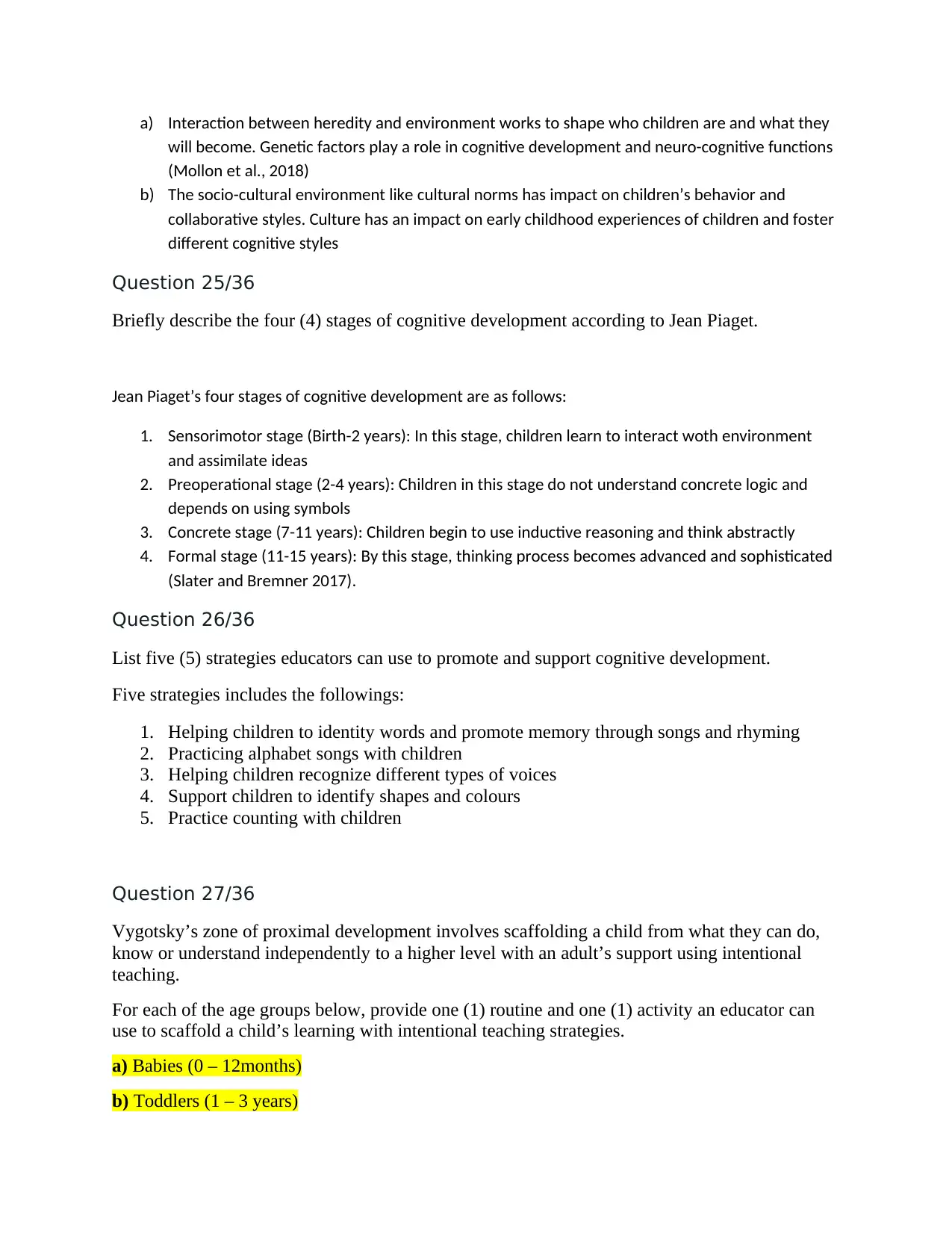
a) Interaction between heredity and environment works to shape who children are and what they
will become. Genetic factors play a role in cognitive development and neuro-cognitive functions
(Mollon et al., 2018)
b) The socio-cultural environment like cultural norms has impact on children’s behavior and
collaborative styles. Culture has an impact on early childhood experiences of children and foster
different cognitive styles
Question 25/36
Briefly describe the four (4) stages of cognitive development according to Jean Piaget.
Jean Piaget’s four stages of cognitive development are as follows:
1. Sensorimotor stage (Birth-2 years): In this stage, children learn to interact woth environment
and assimilate ideas
2. Preoperational stage (2-4 years): Children in this stage do not understand concrete logic and
depends on using symbols
3. Concrete stage (7-11 years): Children begin to use inductive reasoning and think abstractly
4. Formal stage (11-15 years): By this stage, thinking process becomes advanced and sophisticated
(Slater and Bremner 2017).
Question 26/36
List five (5) strategies educators can use to promote and support cognitive development.
Five strategies includes the followings:
1. Helping children to identity words and promote memory through songs and rhyming
2. Practicing alphabet songs with children
3. Helping children recognize different types of voices
4. Support children to identify shapes and colours
5. Practice counting with children
Question 27/36
Vygotsky’s zone of proximal development involves scaffolding a child from what they can do,
know or understand independently to a higher level with an adult’s support using intentional
teaching.
For each of the age groups below, provide one (1) routine and one (1) activity an educator can
use to scaffold a child’s learning with intentional teaching strategies.
a) Babies (0 – 12months)
b) Toddlers (1 – 3 years)
will become. Genetic factors play a role in cognitive development and neuro-cognitive functions
(Mollon et al., 2018)
b) The socio-cultural environment like cultural norms has impact on children’s behavior and
collaborative styles. Culture has an impact on early childhood experiences of children and foster
different cognitive styles
Question 25/36
Briefly describe the four (4) stages of cognitive development according to Jean Piaget.
Jean Piaget’s four stages of cognitive development are as follows:
1. Sensorimotor stage (Birth-2 years): In this stage, children learn to interact woth environment
and assimilate ideas
2. Preoperational stage (2-4 years): Children in this stage do not understand concrete logic and
depends on using symbols
3. Concrete stage (7-11 years): Children begin to use inductive reasoning and think abstractly
4. Formal stage (11-15 years): By this stage, thinking process becomes advanced and sophisticated
(Slater and Bremner 2017).
Question 26/36
List five (5) strategies educators can use to promote and support cognitive development.
Five strategies includes the followings:
1. Helping children to identity words and promote memory through songs and rhyming
2. Practicing alphabet songs with children
3. Helping children recognize different types of voices
4. Support children to identify shapes and colours
5. Practice counting with children
Question 27/36
Vygotsky’s zone of proximal development involves scaffolding a child from what they can do,
know or understand independently to a higher level with an adult’s support using intentional
teaching.
For each of the age groups below, provide one (1) routine and one (1) activity an educator can
use to scaffold a child’s learning with intentional teaching strategies.
a) Babies (0 – 12months)
b) Toddlers (1 – 3 years)
⊘ This is a preview!⊘
Do you want full access?
Subscribe today to unlock all pages.

Trusted by 1+ million students worldwide
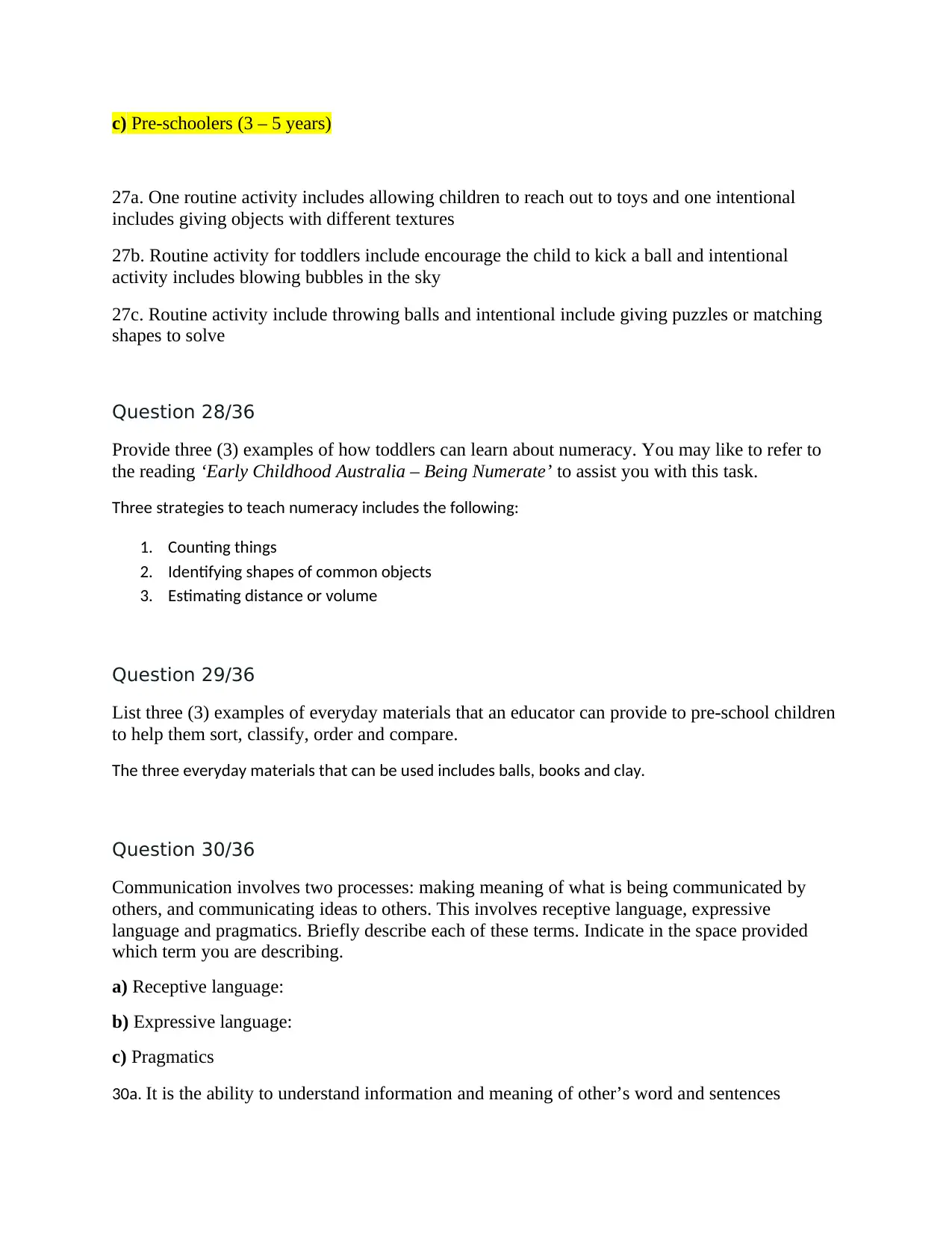
c) Pre-schoolers (3 – 5 years)
27a. One routine activity includes allowing children to reach out to toys and one intentional
includes giving objects with different textures
27b. Routine activity for toddlers include encourage the child to kick a ball and intentional
activity includes blowing bubbles in the sky
27c. Routine activity include throwing balls and intentional include giving puzzles or matching
shapes to solve
Question 28/36
Provide three (3) examples of how toddlers can learn about numeracy. You may like to refer to
the reading ‘Early Childhood Australia – Being Numerate’ to assist you with this task.
Three strategies to teach numeracy includes the following:
1. Counting things
2. Identifying shapes of common objects
3. Estimating distance or volume
Question 29/36
List three (3) examples of everyday materials that an educator can provide to pre-school children
to help them sort, classify, order and compare.
The three everyday materials that can be used includes balls, books and clay.
Question 30/36
Communication involves two processes: making meaning of what is being communicated by
others, and communicating ideas to others. This involves receptive language, expressive
language and pragmatics. Briefly describe each of these terms. Indicate in the space provided
which term you are describing.
a) Receptive language:
b) Expressive language:
c) Pragmatics
30a. It is the ability to understand information and meaning of other’s word and sentences
27a. One routine activity includes allowing children to reach out to toys and one intentional
includes giving objects with different textures
27b. Routine activity for toddlers include encourage the child to kick a ball and intentional
activity includes blowing bubbles in the sky
27c. Routine activity include throwing balls and intentional include giving puzzles or matching
shapes to solve
Question 28/36
Provide three (3) examples of how toddlers can learn about numeracy. You may like to refer to
the reading ‘Early Childhood Australia – Being Numerate’ to assist you with this task.
Three strategies to teach numeracy includes the following:
1. Counting things
2. Identifying shapes of common objects
3. Estimating distance or volume
Question 29/36
List three (3) examples of everyday materials that an educator can provide to pre-school children
to help them sort, classify, order and compare.
The three everyday materials that can be used includes balls, books and clay.
Question 30/36
Communication involves two processes: making meaning of what is being communicated by
others, and communicating ideas to others. This involves receptive language, expressive
language and pragmatics. Briefly describe each of these terms. Indicate in the space provided
which term you are describing.
a) Receptive language:
b) Expressive language:
c) Pragmatics
30a. It is the ability to understand information and meaning of other’s word and sentences
Paraphrase This Document
Need a fresh take? Get an instant paraphrase of this document with our AI Paraphraser
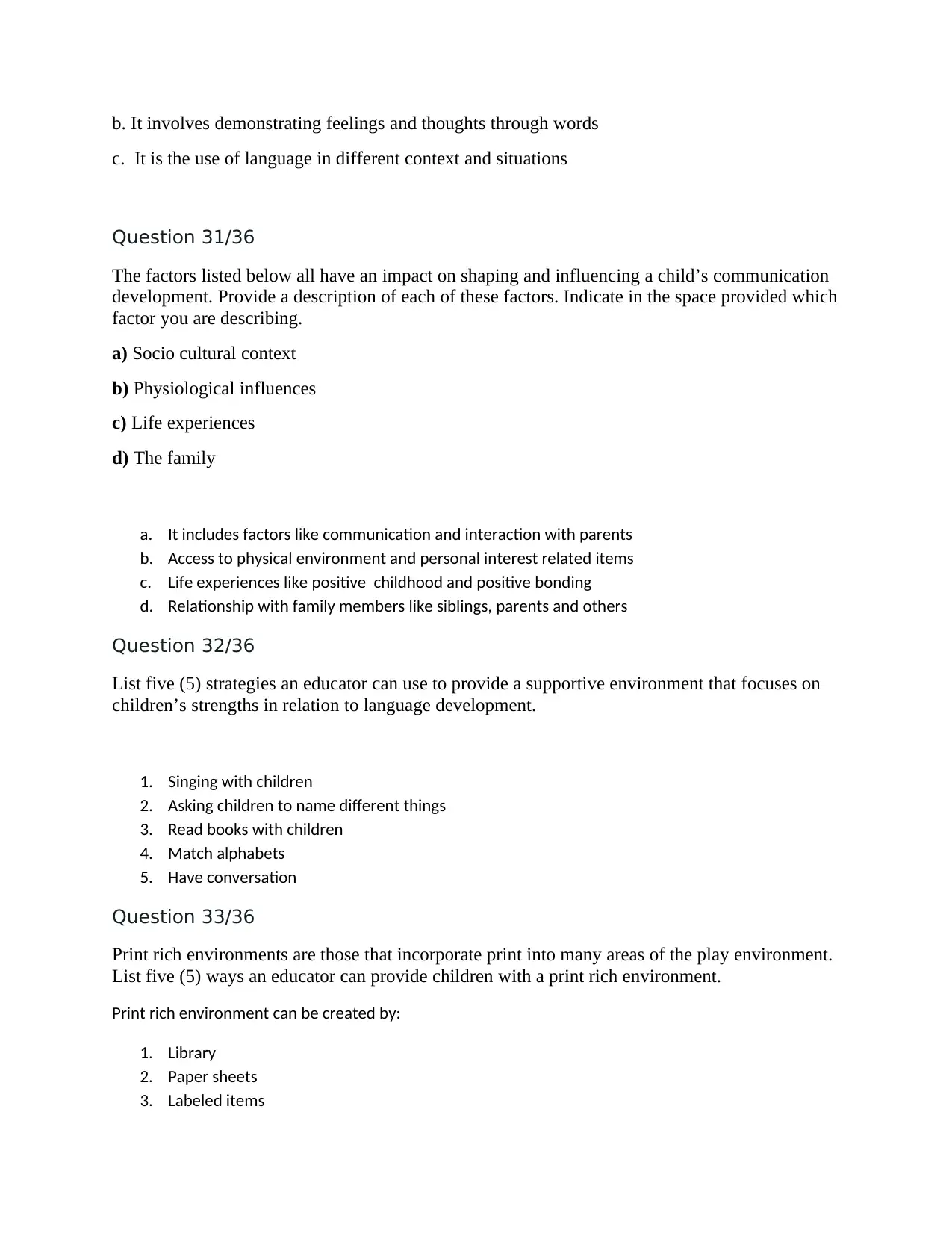
b. It involves demonstrating feelings and thoughts through words
c. It is the use of language in different context and situations
Question 31/36
The factors listed below all have an impact on shaping and influencing a child’s communication
development. Provide a description of each of these factors. Indicate in the space provided which
factor you are describing.
a) Socio cultural context
b) Physiological influences
c) Life experiences
d) The family
a. It includes factors like communication and interaction with parents
b. Access to physical environment and personal interest related items
c. Life experiences like positive childhood and positive bonding
d. Relationship with family members like siblings, parents and others
Question 32/36
List five (5) strategies an educator can use to provide a supportive environment that focuses on
children’s strengths in relation to language development.
1. Singing with children
2. Asking children to name different things
3. Read books with children
4. Match alphabets
5. Have conversation
Question 33/36
Print rich environments are those that incorporate print into many areas of the play environment.
List five (5) ways an educator can provide children with a print rich environment.
Print rich environment can be created by:
1. Library
2. Paper sheets
3. Labeled items
c. It is the use of language in different context and situations
Question 31/36
The factors listed below all have an impact on shaping and influencing a child’s communication
development. Provide a description of each of these factors. Indicate in the space provided which
factor you are describing.
a) Socio cultural context
b) Physiological influences
c) Life experiences
d) The family
a. It includes factors like communication and interaction with parents
b. Access to physical environment and personal interest related items
c. Life experiences like positive childhood and positive bonding
d. Relationship with family members like siblings, parents and others
Question 32/36
List five (5) strategies an educator can use to provide a supportive environment that focuses on
children’s strengths in relation to language development.
1. Singing with children
2. Asking children to name different things
3. Read books with children
4. Match alphabets
5. Have conversation
Question 33/36
Print rich environments are those that incorporate print into many areas of the play environment.
List five (5) ways an educator can provide children with a print rich environment.
Print rich environment can be created by:
1. Library
2. Paper sheets
3. Labeled items

4. Different art works
5. Room with boards
Question 34/36
List five (5) strategies an education and care service can implement to create a welcoming
environment for families.
Five strategies for welcoming environment include the following:
1. Smile and great parents and children
2. Meet family at the door
3. Arrange activities to involve parents
4. Maintain a pleasing and welcoming posture
5. Be a good steward
Question 35/36
Suggest three ways educators can support a child’s dispositions for learning?
The child’s disposition for learning can be supported in the following ways:
1. By cooperating with children and encouraging them to further learn
2. Develop confidence of children
3. Praise children and engage in reflexivity
5. Room with boards
Question 34/36
List five (5) strategies an education and care service can implement to create a welcoming
environment for families.
Five strategies for welcoming environment include the following:
1. Smile and great parents and children
2. Meet family at the door
3. Arrange activities to involve parents
4. Maintain a pleasing and welcoming posture
5. Be a good steward
Question 35/36
Suggest three ways educators can support a child’s dispositions for learning?
The child’s disposition for learning can be supported in the following ways:
1. By cooperating with children and encouraging them to further learn
2. Develop confidence of children
3. Praise children and engage in reflexivity
⊘ This is a preview!⊘
Do you want full access?
Subscribe today to unlock all pages.

Trusted by 1+ million students worldwide
1 out of 13
Related Documents
Your All-in-One AI-Powered Toolkit for Academic Success.
+13062052269
info@desklib.com
Available 24*7 on WhatsApp / Email
![[object Object]](/_next/static/media/star-bottom.7253800d.svg)
Unlock your academic potential
Copyright © 2020–2025 A2Z Services. All Rights Reserved. Developed and managed by ZUCOL.



